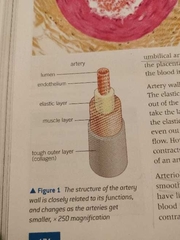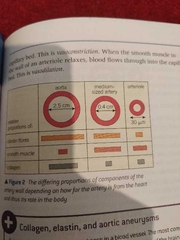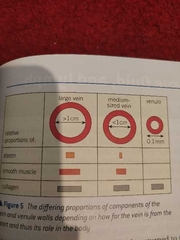![]()
![]()
![]()
Use LEFT and RIGHT arrow keys to navigate between flashcards;
Use UP and DOWN arrow keys to flip the card;
H to show hint;
A reads text to speech;
30 Cards in this Set
- Front
- Back
- 3rd side (hint)
|
why specialised transport system needed in animals? |
. metabolic demands too high and not possible over long distances .sa:v . enzymes and hormones made in a place and needed in another . did donated on one organ system but needs to be carried to every cell for metabolic and respiratory purposes . waste to be removed into excretory organs |
5 reasons |
|
|
common features of most circulatory systems |
. liquid transport medium that circulates around the body eg blood . vessels to carry transport medium . pumping mechanism to move the fluid round the system |
3 |
|
|
haemocoel? |
t medium pumped straight from heart to the body cavity of the animal this open body cavity is haemocoel |
open body cavity |
|
|
insect blood is called? |
haemolymph |
|
|
|
haemolymph role? |
carry food and nitrogenous waste and feels involved in defence against disease |
|
|
|
brief on open, closed, single and double closed |
. |
advantage, disadvantage, fish, explain |
|
|
3 components in blood vessels? |
elastic fibres smooth muscle collagen |
|
|
|
umbilical artery and role? |
during pregnancy carried deoxygenated blood from fetus to placenta a type of artery |
|
|
|
what is the living of artery called And why is it smooth? |
endothelium and so the blood flow easily over it |
|
|
|
arteriole vs artery |
arteriole more smooth muscle less elastin in walls little pulse surge |
|
|
|
artery figure |

|
|
|
|
vasodilation and vasoconstriction? |

when smooth muscle in arteriole contracts, it constricts the vessel and prevents blood flowing into a capillary bed when relaxes, blood flows through into capillary bed |
|
|
|
3 ways capillaries are adapted to their roles |
. provide large sa:v .total cross section area always greater than the arteriole supplying them so more time for exchange as rate of blood flow falls .walls are a single endothelial cell thick so thin layer for diffusione |
|
|
|
what umbilical vein does? |
carries deoxygenated blood from placenta to fetus |
|
|
|
how are walls of veins structured and why |
lots of collagen and little elastic fiber vessels have wide lumen and smooth and thin lining( endothelium) so blood flows more easily |
|
|
|
3 main adaptations that deoxygenated blood under low pressure and against gravity is pumped in the vein to the heart |
. one-way valves that prevent backflow of blood . many big veins run between big and active muscles so when they contract they squeeze vein and force blood back to the heart . breathing movement of the chest acts as a pump as the pressure changes blood in vein of the chest and abdomen to heart |
|
|
|
venule vein figure elastin collagen smooth muscle comparison |

|
|
|
|
what plasma carries? |
.dissolved sugar . amino acid . mineral ions . hormones . large plasma proteins albumin fibrinogen globulins .rbc . white blood cells .platelets . |
|
|
|
what is albumin |
maintaining the osmotic potential of blood |
|
|
|
what is fibrinogen |
blood clotting |
|
|
|
what is globulins |
transport and immune system |
|
|
|
what are platelets what is their function |
fragments of large cells called megacaryocytes in red bone marrow clotting mechanism of blood |
|
|
|
what blood transports |
o2 co2 digested food nitrogenous waste chemical message food molecules platelets cells and antibodies maintenance of steady body temperature acts as a buffer minimising ph changes |
|
|
|
what is oncotic pressure and how much is it |
the tendency of water to move into blood by osmosis about -3.3 kpa |
|
|
|
what is hydrostatic pressure and how much is it at either end? |
as blood flows through arteriole into capillaries, it is still under pressure from the surge of blood that occurs every time the heart contracts at arterial end 4.6 kpa at venous end 2.3 kpa |
|
|
|
what is tissue fluid what happens through it? |
the fluid that's squeezed out of capillaries, fills the spaces between the cells and is called tissue fluid diffusion takes place between the blood and the cells through it. |
|
|
|
explain how tissue fluid moves in and out |

|
Filtration pressure = hydrostatic pressure - oncotic pressure |
|
|
lymph features |
similar composition to plasma and tissue fluid less o2 fewer nutrients fatty acids one-way valves eventually returns to blood into the right and left SUBCLAVIAN veins |
|
|
|
*lymphocytes have defensive role |
. |
|
|
|
how doctors examine for enlarged lymoh nodes and why? |
neck, armpits, stomach, groin a sign that body is fighting off an invading pathogen |
|

